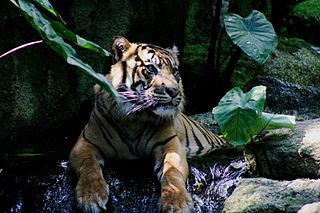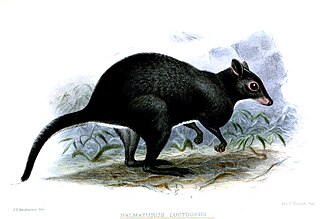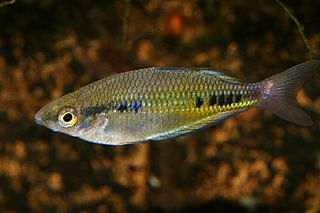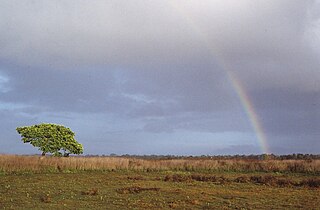Related Research Articles

The fauna of New Guinea comprises a large number of species of mammals, reptiles, birds, fish, invertebrates and amphibians.

The fauna of Indonesia is characterised by high levels of biodiversity and endemicity due to its distribution over a vast tropical archipelago. Indonesia divides into two ecological regions; western Indonesia which is more influenced by Asian fauna, and the east which is more influenced by Australasian species.

Papua New Guinea together with the West Papua region of Indonesia make up a major tropical wilderness area that still contains 5% of the original and untouched tropical high-biodiversity terrestrial ecosystems. PNG in itself contains over 5% of the world's biodiversity in less than 1% of the world's total land area. The flora of New Guinea is unique because it has two sources of origin; the Gondwana flora from the south and flora with Asian origin from the west. As a result, New Guinea shares major family and genera with Australia and the East Asia, but is rich in local endemic species. The endemicity is a result of mountainous isolation, topographic and soil habitat heterogeneity, high forest disturbance rates and abundant aseasonal rainfall year round. PNG boasts some 15–21,000 higher plants, 3,000 species of orchids, 800 species of coral, 600 species of fish, 250 species of mammals and 760 species of birds and 8 species of tree-kangaroos out of which 84 genera of animals are endemic. Ecosystems range from lowland forests to montane forests, alpine flora down to coastal areas which contains some of the most extensive pristine mangrove areas in the world. Much of this biodiversity has remained intact for thousands of years because the ruggedness of the terrain made the interior lands inaccessible; furthermore low population density and restrictions on the effectiveness of traditional tools, ensured that these biodiversity was never overexploited.

Elattostachys is a genus of about 21 species of trees known to science, constituting part of the plant family Sapindaceae.

Lake Kutubu is the second-largest lake in Papua New Guinea, after Lake Murray, and, at 800 m above sea level, the largest upland body of water, with an area of 49.24 km², and a total catchment area of 250 km². Lake Kutubu and Lake Sentani form an ecoregion on the WWF's Global 200. Kutubu lies in the Southern Highlands Province of Papua New Guinea, east of the Kikori River into which it drains, and about 50 km southwest of Mendi, the provincial capital. It is one of the few lakes in the country that occurs in a depression in the rugged interior mountains. The lake has a few islands, the largest of which is Wasemi in its northern part. The water of Lake Kutubu, fed by several streams originating mostly from underground sources, is clear and reaches a depth of 70 m (230 feet). The catchment is inhabited by two main ethnic groups, the Foe to the south and the Fasu to the north. Thirty-three villages lie in the catchment area, with a total estimated population of 10,885.
The southern New Guinea giant softshell turtle is a species of softshell turtle in the family Trionychidae. The species is endemic to the lowlands of southern New Guinea with occasional vagrant individuals sighted off the coast of northern Australia. P. bibroni is referred to by the Suki people as kiya eise, a reference to its flexible shell. In the Arammba language, it is called sokrere, meaning "earthquake". It is sometimes hunted by local villages for its meat and/or eggs, leading to some cases of chelonitoxism.

Parker's snake-necked turtle is a species of turtle in the family Chelidae.
Pritchard's snake-necked turtle is a species of turtles in the family Chelidae. The species is endemic to a restricted area of Central Province, Papua New Guinea.

The gray dorcopsis or gray forest wallaby is a species of marsupial in the family Macropodidae. It is found in West Papua and Papua New Guinea.
Kailola's hardyhead is a species of fish in the family Atherinidae endemic to Papua New Guinea. It reaches a maximum length of 6 cm. It inhabits shallow, clear creeks with gravel substrate. This species was described by Walter Ivantsoff, Lucy Crowley and Gerald R. Allen in 1987 with a type locality of a still backwater of Foasi Creek 3 kilometers west of Safia airstrip in Papua New Guinea. The specific name honours the Patricia J. Kailola, for her contribution to the knowledge of the ichthyology of Papua New Guinea.

The spotted rainbowfish is a species of rainbowfish in the subfamily Melanotaeniinae. It is endemic to the river systems of the Markham and Ramu Rivers in Papua New Guinea. Papua New Guinea. This species was described by Gerald R. Allen in 1981 with the type locality given as a small tributary of the Omsis River, about 22 kilometers west of Lae in the Markham River system, Papua New Guinea.
The Waigeo rainbowfish is a species of rainbowfish in the subfamily Melanotaeniinae. It is endemic to West Papua in Indonesia. It reaches a maximum length of around 7.5 cm. This species was described as Rhombatractus catherinae in 1910 by Lieven Ferdinand de Beaufort|de Beaufort from a type locality which was given as a rivulet flowing into the Rabial River in Waigeo. de Beaufort gave this species the specific name catherinae to honour his wife, Catherine, who had assisted him on the expedition on which the type was collected.

Schultz's pipefish, Corythoichthys schultzi, is a pipefish of the family Syngnathidae.
Yule Island is a small island in Central Province, Papua New Guinea. It is located 160 km NW from Port Moresby, on the south coast of Papua New Guinea.
The Papuan seerfish also called the Papuan Spanish mackerel, is a species of fish in the family Scombridae. It is endemic to the Gulf of Papua off the mouth of the Fly River. It is the smallest species in the genus Scomberomorus. Sexual maturity is attained at much less than 30 cm fork length.

The Wasur National Park forms part of the largest wetland in Merauke Regency, South Papua, Indonesia and has been one of the least disturbed by human activity. The high value of its biodiversity has led to the park being dubbed the "Serengeti of Papua". The vast open wetland, in particular Rawa Biru Lake, attracts a very rich fauna.

Paedophryne amauensis is a species of microhylid frog endemic to eastern Papua New Guinea. At 7.7 mm (0.30 in) in snout-to-vent length, it is considered the world's smallest known vertebrate.
Mendeleev's clingfish is a species of fish in the family Gobiesocidae endemic to Madang Province in Papua New Guinea. This species is the only known member of its genus. This species was described in 2005 by Artem Mikhailovich Prokofiev, the type being collected near the village of Bongu in Madang Province from the research vessel Dmitrii Mendeleev, referred to in its specific name. The vessel was in turn named in hours of the Russian chemist Dmitrii Mendeleev (1834-1907), the creator of the most widely recognised periodic table.
Protogobiesox asymmetricus, is a species of fish in the family Gobiesocidae endemic to the deep-water off the north coast of Papua New Guinea. This species is the only known member of its genus. It is found in association with sunken logs and its unusual lateral symmetry may be an adaptation for this habitat. This species was described by Ronald Fricke, Chen Jhen-Nien and Chen Wei-Jen from a type locality of northeast of Taviltae, Madang Province in Papua New Guinea and these authors placed it in its own subfamily the Protogobiesocinae.
References
- ↑ Living National Treasure. Papua New Guinea Endemic Marine Fish Checklist.
- ↑ Living National Treasure. Papua New Guinea Endemic Freshwater Fish Checklist.
- FishBase 2004: a global information system on fishes. DVD. WorldFish Center - Philippine Office, Los Banos, Philippines. Published in May 2004.
- Catalog of Fishes database, 13 March 2009 version
- Eschmeyer, W. N. and R. Fricke, and R. van der Laan (eds). Catalog of Fishes: Genera, Species, References.